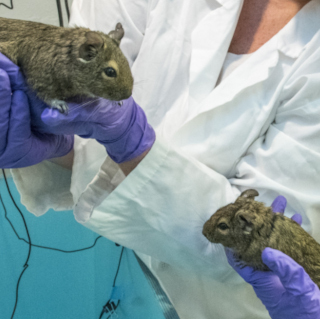Animal Enrichment Program
Last Review Date: May 11, 2021
I. Purpose
This Standard Operating Procedure (SOP) outlines the animal enrichment program, instituted at the University of Montana Laboratory Animal Resources (LAR), which attempts to enrich the daily lives of all the animals within our care. These procedures apply to all personnel involved in the daily care of all species housed within our facilities.
II. Policy
It is a LAR policy to meet or exceed all federal, state, and local regulations and guidelines and to comply with all institutional policies and procedures as they apply to the use of animals in research. LAR personnel or Investigators involved in husbandry and care must pass online animal training modules and attend applicable training in animal care and use, occupational health and safety, and equipment operation prior to performing activities outlined in this SOP. Animal housing rooms should be entered using appropriate personal protective gear for the species and disease or hazard containment level.
III. Procedures
LAR is committed to providing a robust enrichment program for all animals housed within our facilities and used in breeding, experimental, or teaching programs. All species housed in LAR must receive social enrichment through paired or group-housing unless single-housing is scientifically or medically justified. Additional species-specific enrichment (e.g., toys, nesting materials, and novel foods) is provided with pre-approval by the Principal Investigator (PI).
Autoclaved enrichment is placed at the time of bedding changes for all rodents, ensuring placement at least once weekly for those housed in static micro-isolators and bi-weekly for those housed in ventilated cages. One or more of the items listed below may be present at any given time. Larger animals such as rabbits may have enrichment rotated on a biweekly basis. Those animals that require single housing must have a minimum of two items of enrichment placed in their cage.
IV. IACUC-Approved Lists of Enrichment Items
A. Non-food enrichment for rodent species
- Social enrichment
- Human socialization
- Running wheels (plastic or metal as appropriate for the size of the animal)
- Chew toys
- "Nylabone"-type
- Wooden blocks
- Apple branches - organically grown only (degus and snowshoe hares)
- Pine branches (snowshoe hares)
- Hanging platforms (comprised of durable plastic or cardboard products suspended by shower curtain clips)
- Polycarbonate huts - mouse igloo
- Polycarbonate run-about balls for rodents (requires documented and supervised acclimation)
- Paper products, sisal-type, or other natural nesting materials
- Toilet paper rolls
- Environ-Dri, Nestlets
- Shepherd Shacks
- Rodent Nesting Sheets, Bio-Serv
- Egg cartons
- KimWipes
- Paper twists
- PVC tubes
B. Non-food enrichment for rabbits and Lepus sp. (USDA-regulated)
- Durable rubber balls or shapes
- Squeez'n toss footballs
- Taz Ball
- Havaball
- Nobbly Wobbly
- Polycarbonate balls
- Timothy or sisal products made (mats, huts, etc.)
- Durable, empty plastic bottles or aluminum cans for noisemakers
- Durable plastic shelters for climbing and hiding
- Paper bags and cardboard boxes
- Pine or hardwood branches
- Exercise wheel
C. Food-related enrichment for rodents
- Timothy hay
- Irradiated sunflower seeds
- Rose petals – organically grown and as approved by PI’s
- Fruit Loops-type cereal – as approved by PI’s
D. Bird-specific enrichment items
- Sandboxes
- Mirrors
- Rattles
- Sisal, coconut shell-based, wood-based, and polycarbonate manufactured cage toys
- Beak sharpeners
- Cuttlebone
- “Nylabone”-type
- Novel species-specific food supplements (e.g., boiled egg,
live or dried insects, fruits, and vegetables) - Perching devices
- Naturalistic environments (outdoor aviaries) with shrubs, grasses, herbaceous cover, and trees
